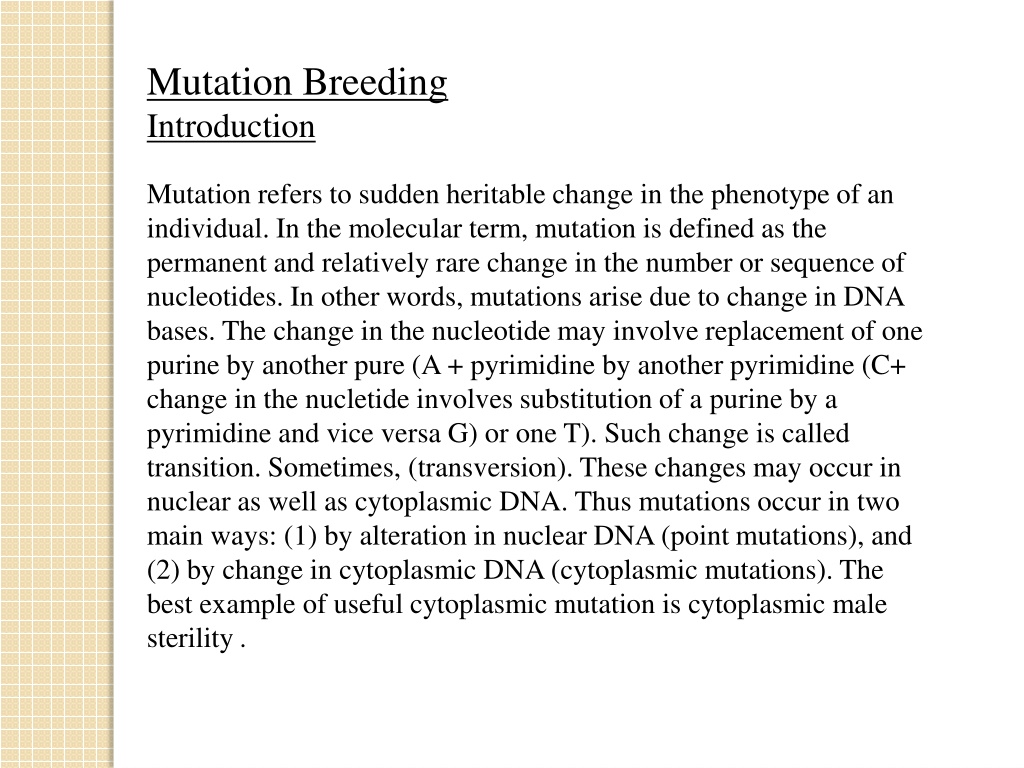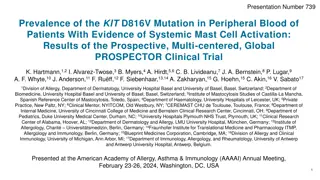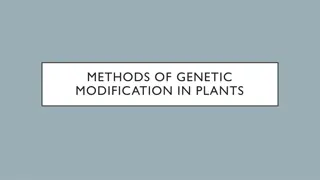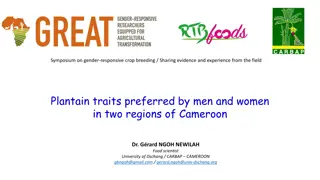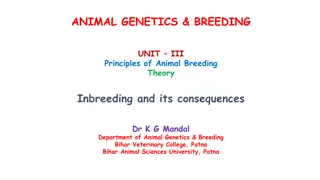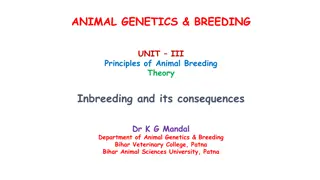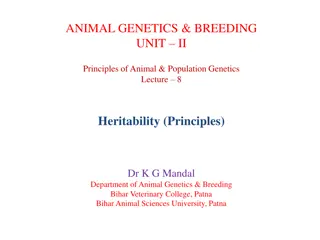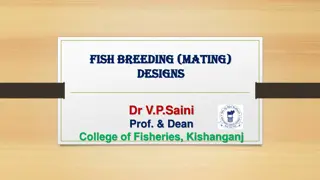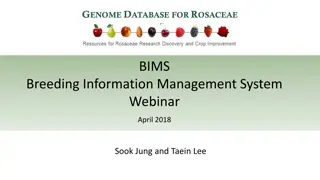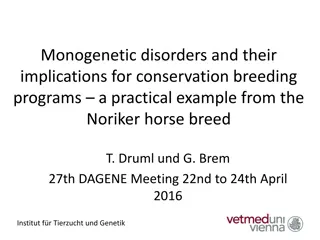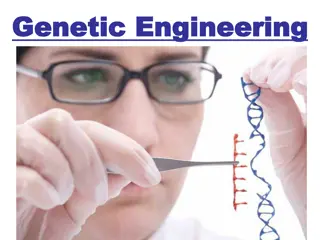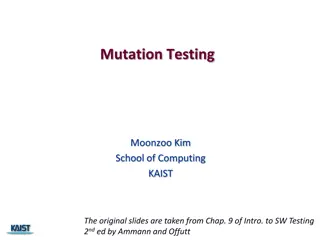Understanding Mutation Breeding in Crop Plants
Mutation breeding involves inducing heritable changes in crop plants through mutations, leading to genetic improvements for economic traits. This method is valuable when desired variability is lacking, for correcting genetic defects, overcoming linkage issues between desirable and undesirable traits, and making improvements in fruit crops without altering taste or color. The process involves macro- and micro-mutations with varying effects on survival, offering a targeted approach to crop improvement.
Download Presentation

Please find below an Image/Link to download the presentation.
The content on the website is provided AS IS for your information and personal use only. It may not be sold, licensed, or shared on other websites without obtaining consent from the author. Download presentation by click this link. If you encounter any issues during the download, it is possible that the publisher has removed the file from their server.
E N D
Presentation Transcript
Mutation Breeding Introduction Mutation refers to sudden heritable change in the phenotype of an individual. In the molecular term, mutation is defined as the permanent and relatively rare change in the number or sequence of nucleotides. In other words, mutations arise due to change in DNA bases. The change in the nucleotide may involve replacement of one purine by another pure (A + pyrimidine by another pyrimidine (C+ change in the nucletide involves substitution of a purine by a pyrimidine and vice versa G) or one T). Such change is called transition. Sometimes, (transversion). These changes may occur in nuclear as well as cytoplasmic DNA. Thus mutations occur in two main ways: (1) by alteration in nuclear DNA (point mutations), and (2) by change in cytoplasmic DNA (cytoplasmic mutations). The best example of useful cytoplasmic mutation is cytoplasmic male sterility .
TYPES OF MUTATIONS Mutations do occur in nature (Spontaneous mutations) as well as can be artificially induced by various mutagenic agents (induced mutations) Induced mutations are of two types, viz.. (1) macro- mutations, and (2) micro-mutations. These are defined below: 1. Macro-Mutations: Mutations with distinct morphological changes in the phenotype are referred to as macro-mutations. Such mutations are found for qualitative characters and, therefore. are also called oligogenic mutations Identification of such mutations is easy. 2. Micro-Mutations: Mutations with invisible phenotypic changes are called micro-mutations. Such mutations are observed in quantitative characters and, hence are also referred to as polygenic mutations. Indentification of such mutations is very difficult. Micro mutations are of economic value in plant breeding.Depending upon the effect on the survival of an individual. induced mutations are of four types namely, (1) lethal (all the individuals carrying such mutations are killed), (2) sub-lethal (mortality is more than 50%), (3) sub-vital (morality is less than 50%), and (4) vital (all mutants survive) .
MUTATION BREEDING The genetic improvement of crop plants for various economic characters through the use of induced motations is referred to as mutation breeding. It is one of the special methods of crop improvement. Mutation breeding is commonly used in self-pollinated and asexually propagated species. However, this method is rarely used for genetic improvement of cross pollinated species Mutation breeding will be rewarding under following situations Chopra and Sharma. 1985) 1. When the desired variability is not found in the cultivated varieties or in the germplasm of cultivated species 2. When a high yielding variety has oligogenic defect such as susceptibility to a disease, mutation breeding is the best course of line for a breeder. Because induced mutagenesis leads to improvement of such variety without much alteration in the genetic background. 3. When there is a tight linkage between desirable and undersirable characters, mutation breeding is the best way of overcoming such problems
4 . When in fruit crops, the improvement has to be made without change in the taste and colour of the fruits, it can best be achieved through mutation breeding, because mutation breeding causes little changes in the genetic background of parental . 5. When a particular reaction is to be blocked, mutation breeding is the only way. For example in opium, synthesis of morphine takes place in step-wise manner. If the biochemical path way is blocked at bane level, it will block the synthesis of morphine without affecting the conversion process of the bane into useful pharmaceutical product. 6. In those crops where sexuality is absent and generation of variability through recombination process is not possible. 7. In those species where generation cycle is very long, such as plantation crops, fruit trees and forest trees, mutation breeding is the short cut way of genetic improvement. 8. When attractive flower and foliage colours have to be developed in ornamental plants which fetch high price in the market, mutation breeding is the only short cut method.
PROCEDURE OF MUTATION BREEDING The mutation breeding process consists of four important steps. These are: (1) choice of material (2) choice of mutagen. (3) mutagen treatment, and (4) handling of treated material. These are briefly discussed below:- 1. Choice of Material: Choice of material is an important step in mutation breeding programme. The best adapted variety of a crop should be chosen for mutagenesis, because such variety has all acceptable agronomic features. Only one or two features of such variety have to be altered through mutagenesis depending upon the objective of mutation breeding Suppose a variety is high yielding, but susceptible to a particular disease, the objective of mutation breeding would be to induce resistance to a paucular disease in the variety. Thus only one character i resistance to disease is induced, other characters remain unchanged. 2. Choice of Mutagen: Various physical and chemical mutagens are used for the induction of mutations. The commonly used muligens include X-rays, gamma rays, ultra violet rays, fast neutrons, thermal neutrons among the physical mutagens, and ethyl methane sulphonate (EMS), methyl methane sulphonate (MMS), ethylene Tine (El) 2.
and several others-among-chemical mutagens. The choice of motagen depends upon the plant parts to be treated Generally, chemical mutagens are more perferred for seed treatment and radiations for the treatment of vegetative parts, because ionizing raditions can easily penetrate the vegetative tissues. The penetration of chemical mutagens can be enhanced dissolving the mutagen in solvents like dimethyl sulphoxide . 3. Mutagenic Treatment: The procedure of mutagenic treatment takes three things into account viz (1) plant species, (2) dose of mutagen, and (3) duration of treatment. In seed propagated species, generally seeds are treated. Pollens are rarely treated because of their short longivity and small quantity. In vegetatively propagated species, buds, cuttings of packers are used for mutagenic treatment. The mutagen dose varies from species to species. A mutation dose close to LD50 is considered optimum by many workers. LD50 refers to a dose of mutagen that kills 50% of the treated individuals. The LD50 dose of same mutagen differs from species to species. The duration of treatment depends on the intensity of radiations or concentration of chemical mutagens. The seeds are water soaked before treatment. After treatment the seeds of cuttings are immediately planted and pollens are used for pollination Plants obtained from treated seeds or cuttings are called M, plants.
Plants grown from the seed obtained from pollination of treated pollens are also called M, plants. 4. Handling of Treated Material: The handling of mutagen treated material differs in seed propagated species and vegetatively propagated species. SEED PROPAGATED SPECIES In seed propagated species, the general procedure for handling of mutagen treated material consists of five important steps as discussed below: 1. M1 Generation: A large M, population is raised from treated seeds. Plants are grown using wider spacing for easy identification. Generally, the mutants are recessive. If some dominant mutations are obtained, they are selected in M,; otherwise observations are recorded on chlorophyll sectoring and fertility. All the M, plants are selfed to avoid contamination from cross pollination. Each M, plant is harvested separately. 2. M2 Generation: The M, generation is raised from the seed obtained from M, using wider spacings. The oligogenic mutants with distinct features are identified and selected. The seed of such mutants is harvested separately.
3. M3 Generation: The M, progeny are raised from selected M, and evaluated for homozygosity. The homologous M, progeny are bulked together to conduct yield trial in M, generations. 4. M4 Generation: The M, progeny are raised in replicated trial using local check for comparison 5. M5-M9 Generation : Selected lines are tested in coordinated multilocation trials. The best performing line is released as a variety. In case of polygenic traits, identification of character is not possible through visual observations. The material is tested in replicated trial and screening is done for the character under improvement using appropriate statistical methods. Inferior plants are rejected in M, and M, generations based on screening tests and superior plants are bulked to raise next generation. The homozygous progeny are tested in coordinated trial from M, to M, and the best line is released as a variety.
Vegetatively Propagated Species 1. VM1 Generation : Large number of cuttings are treated with mutagen. The treated cuttings are planted and M1 plants are raised. The canes showing sectorial chimera or pericliual chimera are selected 2. VM2 Generation: Cuttings from the plants selected in VM1 are grown in separate rows in VM2. The solid mutants are identified and selected in VM2 . 3. VM3 Generation: Cuttings from the plants selected in VM2 are grown in separate rows. Their breeding behaviour is confirmed. Identical progeny are bulked together. 4. VM4 Generation: Replicated trial of selected mutants is conducted using local variety as a check. 5. VM5 to VM9 Generation: The selected mutant lines are tested in coordinated trials at multilocations . The best line is released as a new variety.
Applications In Crop Improvement 1. Development of improved varieties 2. Induction of male sterility 3. Production of haploids 4. Creation of genetic variability 5. Overcoming self incompatibility 6. Improvement in adaption Advantages Mutation breeding has several advantages. Some important advantages of mutation breeding are briefly presented below: 1. Induced mutagenesis is used for the induction of cytoplasmic male sterility. Ethidium bromide (EB) has been used for induction of cytoplasmic male sterility in pearlmillet (Burton and Hanna, 1976) and barley (Minocha et al., 1983). 2. 2. Mutation breeding is a cheap and rapid method of developing new varieties as compared to backcross, pedigree and bulk breeding methods. 3. 3. Mutation breeding is more effective for the improvement of oligogenic characters such as disease resistance than polygenic traits.
Limitations Induced mutations have some limitations which are briefly presented below: 1. Most of the mutations are deleterious and undesirable. 2. 2. Identification of micro-mutations, which are more useful to a plant breeder is usually very difficult. 3. 3. Since useful mutations are produced at a very low frequency (0.1%), a very large plant population has to be screened to identify and isolate desirable mutants. 4. 4. Mutation breeding has limited scope for the genetic improvement of quantitative or poly- genic characters.
Polyploidy Breeding INTRODUCTION An organism or individual having more than two basic or monoploid sets of chromosomes is called polyploid and such condition is known as polyploidy Genetic improvement of crop plants through manipulation of chromosome number is called polyploidy breeding. It is estimated that about one third species of flowering plants are polyploids. In wild species of grass family polyploidy has been reported upto 70%. In animals, polyploidy is rare because of its lethal effects. It is found only in those species of animals which develop parthenogenetically like aphids. Polyploidy is of two types, viz. (1) autopolyploidy (2) allopolyploidy.
Types of polyploidy Autopolyploidy Polyploids which originate by multiplication of the chromosome of a single species are known as autopolyploids or autoploids and such situation is referred to as autopolyploidy jin other words, autoploidy refers to the situation in which (additional sets of chromosomes arise from the same species. Autoploids include (triploids (3x), tetraploids (4) pentaploids (5x)) hexaploids (6x). septaploids (7x) (octaploids (87) and so on. Autoploids are also known as simple polyploids or single species polyploids. a)Autotriploids They have three sets of chromosomes of the same species. They can occur naturally or can be produced artificially by crossing between autotetraploid and diploid species. Triploids are generally highly sterile due to defective gamete formation. Triploids are useful only in those plant species which propagate asexually like banana, sugarcane, apple etc. A few examples of practical uses of autotriploidy are given below:
1. Banana Cultivated varieties of banana are triploids and seedless. Such bananas have larger fruits than diploid ones. 2. Apples: Some varieties of apple are triploids which are propagated asexually by budding or grafting. 3. Sugarbeet: Triploid sugarbeets have higher sugar contents than diploids and are generally resistant to moulds. 4. Watermelon: Triploid watermelons are seedless or have rudimentary seeds like cucumber. These seedless watermelons are produced by crossing tetraploid female with diploid male. However, the reciprocal cross is not successful. All other autoploids with odd chromosome sets, viz pentaploids, septaploids, etc. also behave like triploids.
b)Autotetraploids They have four copies of the genome of same species. They may arise spontaneously or can be induced artificially by doubling the chromosomes of a diploid species with colchicine treatment. [Tetraploids are usually very stable and fertile because pairing partners are available during meiosis. In such individuals diploid gametes (2n) are formed. Autotetraploids are usually larger and more vigorous than the diploid species, rye, grapes, alfalfa, groundnut, potato and coffee are well known examples of autotetraploids . A few cases of practical use are described below: 1. Rye : Autotetraploid rye is grown in Sweden and Germany. They have larger seeds and higher proteins than diploids. 2. Grapes: Tetraploid grapes have been developed in California, USA, which have larger fruits and fewer seeds per fruit than diploids. 3. Alfalfa: Tetraploid varieties of alfalfa are better than diploid in yield and have better recovery after grazing.
ALLOPOLYPLOIDY A ployploid organism which originates by combining complete chromosome sets from two or more species is known as allopolyploid or alloploid and such condition is referred to as allopolyploidy: Alloploids are also known as hybrid polyploids or bispecies or multispecies polyploids. An allopolyploid which arises by combining genomes of two diploid species is termed as allotetraploid or amphidiploid. Allopolyploidy can be developed by interspecific crosses and fertility is restored by chromosome doubling with colchicine treatment. Alloploidy has played greater role in crop evolution than autopolyploidy, because allopolyploidy is found in about 50% of crop plants.
Induction of polyploidy Polyploidy is mainly induced by treatment with a chemical known as colchicine. This is an alkaloid which is obtained from the seeds of a plant known as Colchicum autumnale, which belongs to the family Liliaceae. Colchicine does not affect Colchicum from which it is extracted, because this plant has an anticolchicine substance. Colchicine is applied in a very low concentration, because high concentration is highly toxic to the cells. For effective induction of polyploidy, usually concentrations of 0.01% to 0.5% are used in different plant species. The colchicine induced polyploidy is known as colchiploidy. In plants colchicine is applied to growing tips, meristematic cells, seeds and axillary buds in aqueous solution or mixed with lanolin. The duration of treatment varies from 24 hours to 96 hours depending upon the species of plants. Colchicine induces polyploidy by inhibiting formation of spindle fibres. The chromosomes do not line up on the equatorial plate and divide without moving to the poles due to lack of spindle fibres. The nuclear membrane is formed around them and the cell enters interphase. Thus nucleus has double the chromosome number.
Effects of polyploidy 1. Stems are thicker and stouter 2. Leaves are thicker , fleshy , larger, and deeper green in colour 3. Roots are stronger and longer 4. Flowers, pollen and seeds are larger than diploids 5. Maturity duration is longer and growth rate is slower than diploids 6. Water contents are higher than diploids . Application in crop improvement Polyploidy plays an important role in crop improvement. Both autopolyploidy and allopolyploidy are useful in several ways. However, allopolyploidy has wider applications than autopolyploidy. Applications of autopolyploidy and allopolyploidy in crop improvement are briefly presented below: a)Autoploidy Both triploids and tetraploids have been used in crop improvement. However, their applications have been limited to few species only. Autotriploids have been developed in sugarbeets and watermelon.
Triploid sugarbeets have larger roots and higher sugar contents than diploids. Triploid watermelons are seedless or have rudimentary and soft seeds like cucumber. The triploid seed is produced by using tetraploid as female and diploid as male. The reciprocal cross is not successful. Moreover, triploid watermelons have irregular shape and fresh seeds have to be made every year. Autotetraploids have been developed in forage crops like berseem, alfalfa and rye; vegetables like radish, turnip and cabbage; and fruits like grapes. Tetraploid varieties of rye are grown in Sweden and Germany. They have larger seeds and higher proteins than diploids. Tetraploid grapes have been developed in California USA, which have larger fruits and fewer seeds per fruit than diploids. Tetraploid varieties of alfalfa are better than diploid in yield and recovery after grazing. However, tetraploid cabbage and turnips have higher water contents than diploids. b)Alloploidy 1)Tracing the origin of crop species 2)Creation of new species 3)Interspecific gene transfer 4)Bridging cross
Limitation of polyploidy Polyploidy has several limitations. Some important limitations of polyploidy in crop improvement are briefly presented below: 1. Limited use: The single species polyploidy has limited applications. It is generally useful in those crop species which propagate asexually like banana, potato, sugarcane, grapes etc. 2. Difficulty in maintenance: The maintenance of monoploids and triploids is not possible in case of sexually propagating crop species. 3. Undesirable characters: In bispecies or multispecies polyploids characters are contrib uted by each of the parental species. These characters may be sometimes undesirable as in case of Raphanobrassica. 4. Some other defects: Induced polyploids have several defects such as low fertility, genetic instability, slow growth rate, late maturity, etc. 5. Chances of developing new species through allopolyploidy are extremely low.
